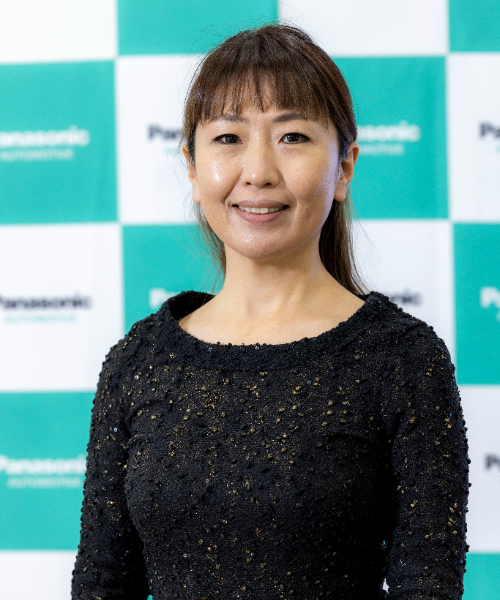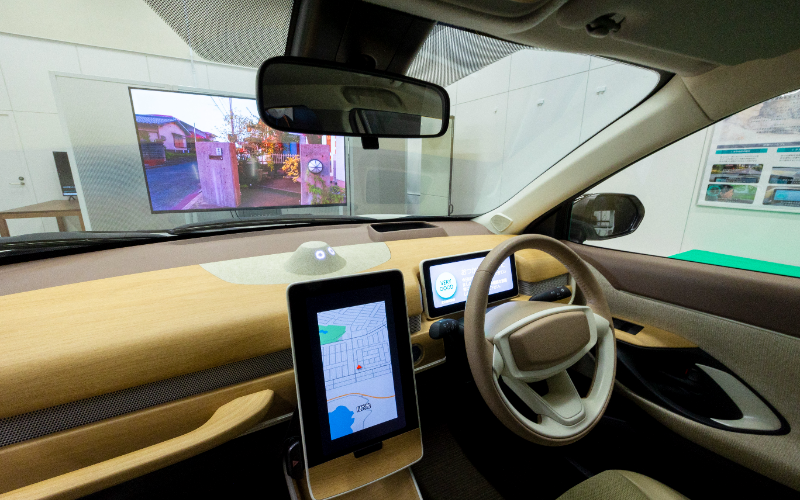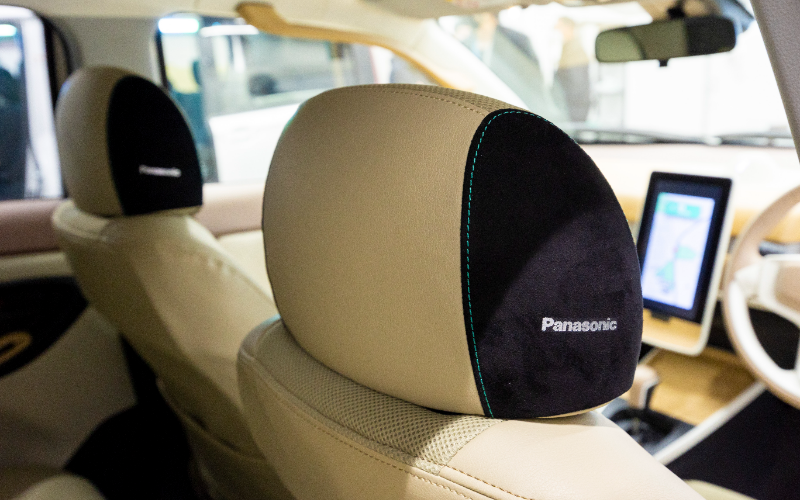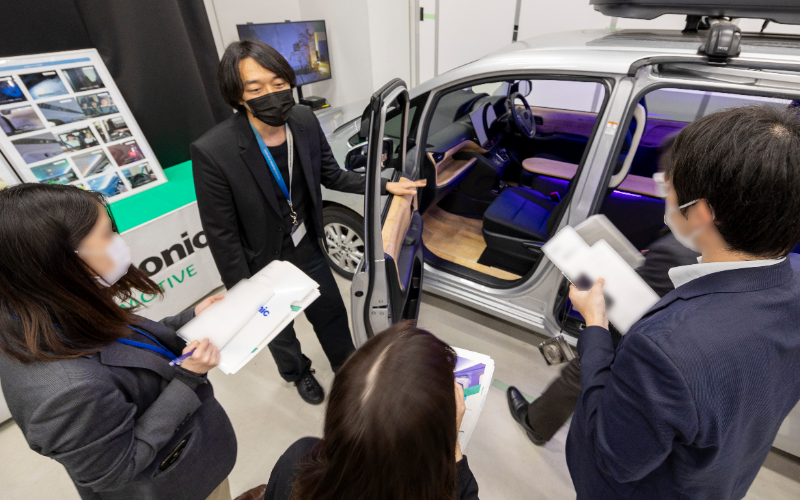Proposing New Interior Value with a Focus on People and Their Lifestyles
Cabin-Interior Innovation Office
Proposing unique and innovative solutions
While the expectations for developments in mobility services are steadily growing in the automobile industry, the industry itself is seeing drastic changes as major IT corporations like Google and Apple announce their entry into the automotive market.
Against the backdrop of this industrial revolution, rather than leaving car manufacturers to create products that fit predetermined specifications, Panasonic Automotive Systems Co., Ltd. is dedicated to creating new business through new value that focuses on people and their lifestyles. The driving force behind this initiative is the Cabin-Interior Innovation Office.

From B-to-B to B-to-C with input from 60,000 users
Keiko Ohta, Head of the Cabin-Interior Innovation Office, is a marketing professional that has helped develop Panasonic’s beauty appliances (Panasonic Beauty) into hit products. She has leveraged her experiences as a designer to further her activities in the areas of home furnishings and appliances.
Under the leadership of Ms. Ohta, Panasonic Automotive began to move away from B-to-B (business-to-business) transactions by introducing B-to-C (business-to-consumer) marketing methods. This has led to a new approach to car design, one that focuses on people and their lifestyles by meeting the needs of drivers and passengers—those most closely interacting with the vehicle—rather than furthering the evolution of vehicle functions purported by car manufacturers and suppliers. This unique goal establishes cars as a part of the lives of users as an extension of their living space, a perspective that car manufacturers have never taken before.

Appointed as Executive Officer of Panasonic Automotive Systems Co., Ltd. in April 2023
Concurrently serving as General Manager of the HMI Systems Business Division
Ms. Ohta and the members of her team utilize demographic surveys and other macro information sources to anticipate industry trends in addition to commercial trends based on changes in technologies—including those related to the environment—and applicable laws and regulations. In addition, utilizing survey data from 60,000 end users, the Cabin-Interior Innovation Office recognizes drivers as the target individuals for new products. This makes it possible for the Office to identify the various needs of drivers and to install products in actual vehicles to verify products. Applying the PDCA cycle for each product helps strengthen every proposal Panasonic Automotive gives to car manufacturers and other related parties.
Such proposals have been highly valued by car manufacturers, with many noting the uniqueness and originality of Panasonic Automotive’s proposals, and others expressing interest in future perspectives from Panasonic with the people and their lifestyles in mind.
Learn more about cabin innovation solutions:https://automotive.panasonic.com/cabin-space
Testimonials from three designers whose designs have been brought to life.

From right: Mr. Masuda, Mr. Nishida, and Mr. Tanaka (Below) Introducing PoC products to media representatives.
[Mr. Masuda] Vehicle interiors that encourage senior drivers.

Q. How do you approach production while adhering to the “Uniquely Panasonic” ideal?
We started with web-based surveys of 60,000 people, and then we dug deeper into a variety of related themes with surveys for seniors. By the time we were done, we had spent about 10 hours on one-on-one interviews with eight individuals. This process allowed us to identify various customer lifestyle issues to develop a UX design with a greater focus on the customer experience. I think prioritizing people and their lifestyles has helped us establish uniquely Panasonic ideas in meeting the needs of every customer.
For example, we developed a feature that uses microphones to pick up sounds from outside the car and transmits them to the driver and passengers inside the car through their headrests even while driving. While sound-dampening technologies have made the inside of the car incredibly quiet, this idea came about because many senior drivers with hearing difficulties didn’t feel like they were really driving when the windows were closed. While delivering sounds to drivers provided greater insight into road and vehicle conditions, passengers do not need such detailed information, and this led us to optimize the individual sound outputs.


Q. What did it take to make your prototype a reality?
Because this was a new proposal, installing the system in a fully operational vehicle was difficult. But it was important for us to use an actual vehicle rather than offer a static design model to ensure users could experience the system’s UX value for themselves. We consulted with a variety of individuals both inside and outside the company who provided us with various materials and devices. We were ultimately able to bring many features to life through collaborations with members from other in-house business divisions.
Q. What did car manufacturers think of the system?
Because we developed the system with careful consideration for input from end users, the system was extremely well received by car manufacturers. We were also able to get car manufacturers to recognize the value of the system. In the end, car manufacturers are car specialists, so we wanted to take advantage of their help in creating the system by sharing our ideas and getting feedback from them.
[Mr. Nishida] Strengthening family ties through vehicle interiors.

Q. What are some innovations you’ve been working on?
While there are plenty of cars in the market today designed with families in mind, we wanted to focus more on strengthening family values, which was a unique approach. For example, a large table is one personification of a family’s values. So, instead of individual tables for each seat like those found on bullet trains, we set out to put a large, single-piece table down the center of the car.

Many of the families we interviewed reported that everyone would generally be in their own little worlds even when they were in the same car. This proposal came from our desire to reaffirm traditional family values and the bonds that bind families together. This was actually my first time working from survey data, and I was surprised by many of our findings. Incorporating those findings into new proposals for strengthening family ties—the theme of our project—was the most difficult part.
Q. What kind of feedback did you receive from car manufacturers?
When talking with car manufacturers, I felt that they also wondered what the future of the automobile should be. And that is precisely why we began looking for ideas from new perspectives. Many of those we spoke with about the table project admitted they hadn’t thought of it before and were interested in the idea behind the project.
In general, car manufacturers focus on the mobility perspective, with vehicle interiors being an additional element. Our proposals, however, focus on increasing the value of the interior itself.
Q. What proposals are you looking to explore in the future?
Our goal is to increase the happiness of users through products that help create happiness in their daily lives. While to some this may seem like fluffy thinking, I feel it is an important issue to address.
[Mr. Tanaka] Vehicle interiors for Generation Z

Q. How did you go about surveying Generation Z?
While we held many user surveys, we didn’t set out with Generation Z in mind. Instead, we worked together with Generation Z friends and family . We wanted to look closer at the thoughts of Generation Z, not just in terms of mobility but also in a broader sense, such as their lifestyles, values, interests, and preferences. The overwhelming majority of Generation Z disdains stereotyping.
So, when developing this proposal, we looked to new members of urban society to better understand what Generation Z had to say about cars.
Q. And what did you find?
We found that even those that owned cars only used their cars for a small part of the day. For Generation Z, this makes cars a wasted resource. So, our goal was to find ways to use cars not just for transportation but as a personal space.
To be honest, I was a little dismissive of this idea at first. But, after using my own car or even a rental car as a personal space, I came to agree with it, even though there were some challenges. While visibility from the outside and heating or cooling the space was still an issue, the cozy interior we created by not being able to see the driver’s seat was incredibly inviting.

This project made me realize just how differently from other generations Generation Z sees the world. It really highlighted the importance of trying things out before dismissing them out of hand.
Q. What future projects are you looking to now?
*The affiliated groups and positions listed in this article are current as of March 2023.